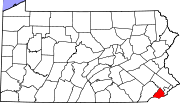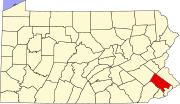Wayne, Pennsylvania
Wayne, Pennsylvania | |
|---|---|
 Wayne Station | |
 Wayne, Pennsylvania Location of Wayne in Pennsylvania | |
| Coordinates: 40°02′38″N 75°23′16″W / 40.04389°N 75.38778°WCoordinates: 40°02′38″N 75°23′16″W / 40.04389°N 75.38778°W | |
| Country | |
| State | |
| Counties | Delaware |
| Townships | Radnor |
| Elevation | 117 m (384 ft) |
| Time zone | UTC-5 (EST) |
| • Summer (DST) | UTC-4 (EDT) |
| ZIP codes | 19080, 19087-19089 |
| Area code(s) | 610 and 484 |

Wayne is an unincorporated community centered in Delaware County, Pennsylvania, on the Main Line, a series of highly affluent Philadelphia suburbs located along the railroad tracks of the Pennsylvania Railroad and one of the wealthiest areas in the nation. While the center of Wayne is in Radnor Township, Wayne extends into both Tredyffrin Township in Chester County and Upper Merion Township in Montgomery County. The center of Wayne was designated the Downtown Wayne Historic District in 2012.[1] Considering the large area served by the Wayne post office, the community may extend slightly into Easttown Township, Chester County, as well.
The center of the Wayne business district is the intersection of Lancaster Avenue and Wayne Avenue, its main street. The historic Wayne station is located one block north of this intersection. The Wayne business district also includes a post office, a cinema, a hotel, a library, the new Radnor Middle School, and several banks, stores, restaurants, cafes, bars and other commercial establishments. Other institutions and attractions in Wayne include the Wayne Hotel, Chanticleer Garden, and the Valley Forge Military Academy and College.
History[]

Wayne's development began when a railroad stop called Cleaver's Landing was established. It was renamed Wayne Station after General Anthony Wayne. Parcels in the area totaling 293 acres (1.19 km2) were bought by banker J.H. Askin, where he built a mansion named "Louella" after his daughters Louisa and Ella. "Louella" was described as an 80-room stone building with a large porch overlooking manicured lawn.[2] His and surrounding land were bought in 1880 by banker A.J. Drexel and newspaper editor G.W. Childs, to form a larger development they called Wayne Estate.[3] More homes and a hotel were then built. In a brochure from 1887 about their development they noted they had provided Wayne with "water, light and drainage — the three great conveniences of a large city — by the most approved modern methods." They described Wayne Estate as follows:
The suburban village known as Wayne, on the Pennsylvania Railroad, fourteen miles from Philadelphia, differs so much from the ordinary town allowed to grow up hap-hazard and to develop conveniences as population increases, that it is necessary, in describing it as it appears, to keep in mind some facts about its history. Wayne is not an accidental aggregation of cottages; it is a town built by design, and provided at the start with all the conveniences to which residents of cities are accustomed and which they are so apt to miss and long for when they go into the country or even into the suburbs of a great city. The scheme of the town was well thought out and planned before any of the new cottages were built, and, as it was undertaken by liberal gentlemen of abundant means, no expense was spared in the preliminary municipal work.
The Chanticleer Garden, Downtown Wayne Historic District, North Wayne Historic District, Pennsylvania Railroad Station at Wayne, South Wayne Historic District and Wayne Hotel are all located on the National Register of Historic Places.
Geography[]
Wayne is located on the Main Line (the Paoli/Thorndale Line on SEPTA Regional Rail). The central business district of Wayne is located at the intersection of Lancaster and Wayne Avenues in Radnor Township, Delaware County, Pennsylvania. The area served by the Wayne ZIP code (19087) is large and encompasses areas both in Radnor Township, Delaware County and in the neighboring adjacent municipalities of Upper Merion in Montgomery County and Tredyffrin in Chester County, including the communities of Radnor, Strafford, St. Davids, and Chesterbrook.
Transportation[]
St. Davids station, Wayne station, and Strafford station on the Paoli/Thorndale SEPTA Line are in Wayne.
Demographics[]

Since Wayne is neither an incorporated area nor a census-designated place, all the data is for the ZIP code 19087. As of the census of 2010, there were 32,225 people and 12,754 households residing in the community. The median age was 40.8. The racial makeup of the community was 85.5% White, 7.9% Asian and 5.3% African American, while 3.7% of the population was Hispanic or Latino of any race. The median income for a household in the community was $118,801, and 5.1% of the population was below the poverty line.[4]
Economy[]
Teleflex, Kenexa, and DLL Group (U.S.) are based in Wayne.
Education[]
Elementary and high school[]
Public schools[]

Pupils in the Radnor Township portion of Wayne attend schools in Radnor Township School District, while pupils in the Tredyffrin portion attend schools in Tredyffrin/Easttown School District. Those in the northeastern portion of the community in Upper Merion Township attend the Upper Merion Area School District.
Students in Radnor Township attend Radnor High School. Students in Tredyffrin Township attend Conestoga High School. Students in Upper Merion Township attend Upper Merion Area High School.
Catholic schools[]
The St. Katharine of Siena School is a Catholic K-8 grade school located in downtown Wayne operated by the Archdiocese of Philadelphia. Catholic students who live in Radnor Township as well as other towns in the Delaware Valley may choose to attend Archbishop John Carroll High School, located in the nearby community of Radnor.
Private schools[]
Many private schools are also located nearby including the Quaker-affiliated Shipley School in Bryn Mawr, all-boys Haverford School in Haverford and all-girls Agnes Irwin School in Rosemont, all located east of Wayne.[citation needed] Episcopal Academy, opened in 2008 to the south in Newtown Square, has quickly become another popular option.
The Valley Forge Military Academy and College is also located in Wayne.
Post-secondary[]
Nearby post-secondary institutions include Villanova University, Cabrini University and Eastern University. Valley Forge Military Academy is also a junior college.
YSC Academy[]
The Philadelphia Union of Major League Soccer opened its own private school called YSC Academy on September 3, 2013. The Wayne-based academy is designed for student-athletes the club aims to groom for professional soccer. The initial 32 pupils already had experience playing for one of the Union's academy and Juniors teams.[5]
Notable people[]

- Diane Meredith Belcher, concert organist, teacher, church musician
- Robert Elmore, organist, composer, teacher
- Mark Herzlich, football player
- Kasie Hunt, journalist
- Abbi Jacobson, actress
- Karl Kirchwey, poet
- Daylin Leach, state senator for the 17th district
- Ned Martin, sportscaster
- Anna Moffo, opera singer
- Lisa Raymond, tennis player
- Rafael Robb, economist
- Jerry Spinelli, author
- Larri Thomas, actress and dancer
- Thomas F. Wilson, actor
- Harold Wright, clarinetist
- Joshua Wurman, scientist
Points of interest[]

- Chanticleer Garden
- St. Davids Church
- Wayne Hotel
- Radnor Trail System
- Anthony Wayne Theater - art deco-style movie theater
- Eagle Village Shops
- Farmer's Market
- Downtown Wayne
- Ardrossan Estate
- Old Eagle School
- The Wayne Art Center, established in 1930
References[]
- ^ "National Register of Historic Places Listings". Weekly List of Actions Taken on Properties: 9/29/12 through 10/05/12. National Park Service. 2012-10-12.
- ^ Library Company of Philadelphia: 2002 Annual Report. Philadelphia. 2003. p. 63. ISBN 9781422373149.
- ^ Ashmeade, Henry Graham (1884). History of Delaware County, Pennsylvania. Philadelphia: L.H. Everts & Co. p. 682. Retrieved 16 June 2017.
- ^ "American Fact Finder - Community Facts". United States Census Bureau. Archived from the original on 2020-02-13. Retrieved 2017-01-30.
- ^ "Philadelphia Union's YSC Academy opens its doors: "It's a landmark day" for the club's future". September 23, 2009. Retrieved September 6, 2013.
External links[]
| Wikimedia Commons has media related to Wayne, Pennsylvania. |
- Pennsylvania Main Line
- Radnor Township, Delaware County, Pennsylvania
- Unincorporated communities in Montgomery County, Pennsylvania
- Unincorporated communities in Delaware County, Pennsylvania
- Unincorporated communities in Chester County, Pennsylvania
- Unincorporated communities in Pennsylvania




